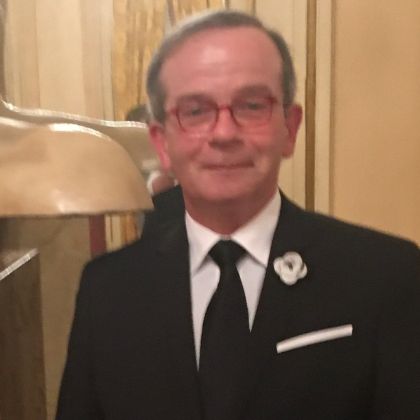Boléro, Le Baiser de la fée and Perséphone, Le Martyre de Saint-Sébastien amongst others all owe their life to Ida Rubinstein as muse, patron, or performer (often all three). A celebrated dancer and actress, independently wealthy, and a cultural and fashion icon in Paris during the first forty years of the 20th century, she commissioned her final piece in 1933 from her frequent collaborator, Arthur Honegger, and the poet/playwright, Paul Claudel – Jeanne d’Arc au bûcher, a dramatic oratorio inspired by medieval mystery plays and conceived as part of a “tetralogy of evil”. War intervened and the tetralogy remained forever incomplete, but Jeanne went on to be performed frequently, becoming a source of French pride and resistance. Honegger and Claudel added a prologue in November 1944, adopting the words of Genesis to describe France and its wartime plight, further cementing the identification of the nation with its patron saint.
Odyssey Opera chose as its venue Sanders Theater, part of Memorial Hall, a High Gothic pile on the Harvard campus. Oxford’s Sheldonian provided the model for the shape and layout of Sanders. Its dark, gothic woodwork provided the perfect backdrop for Honegger’s oratorio. A triangular space at the center of the stage contained the action, instruments on either side. The conductor’s podium was moved to the left leaving the area unobstructed. The main chorus, all in black, lined up in rows along the back, the children’s chorus, in black as well, stood at the right end of the balcony, while the two saints, in light pink and gold gowns, sang from opposite sides of the orchestra at the ends of the first row of seats. The Holy Virgin, in a sparkling, celestial blue gown, appeared in the balcony on the left. Blue, violet, green and flaming orange lights painted the stage to set the mood for individual scenes.
Joan entered in a simple shift, leather sandals laced to the ankle, and holding her sword aloft. Shura Baryshnikov’s movements were fluid and supple, defining character and space with the line of her poses. Some of her movements and attitudes, whether by design or accident, suggested some of Rubenstein’s as preserved in sketches and drawings. But it was her face which expressed the most, youthful and girlish as she relived her childhood in Lorraine, transfigured by the inner light of an ecstatic faith as she fixed her eyes on the Virgin before her execution. She and Brother Dominic, the other speaking role, wore body mikes. Others in the cast would have benefited from the same since inaudibility undermined spoken passages, particularly when characters were not facing out.
Claudel’s libretto straddles dark and light, heaven and earth, and a variety of theatrical genres. Honegger follows suit deploying plainchant, processional, Baroque pastiche, jazz, folk music, contemporary ballroom dances, and the techniques of the soundtrack with an orchestra whose unique voice derives its colors from four bassoons, three clarinets, three saxophones, harpsichord and piano, the total absence of horns, and spectral glissandos from the ondes martenot.
“Joan Delivered to the Beasts” best illustrates their method, recasting the kangaroo court condemning Joan as an animal fable with the presiding judge, Bishop Pierre Cauchon, transformed into Porcus/Cochon, the other officers of the court into a fox, a wolf, a serpent, an ass and the jury into a flock of sheep. Honegger sets the proceedings as a wild, biting, song-and-dance burlesque. Frank Kelley, in bright pink with a curly tail and a pig’s head cap, hammed it up as Porcus acting like a glad-handing politician as he circulated through the audience and navigated the high tessitura of his part. Here as elsewhere, the Odyssey Opera Orchestra and the choruses took on the different colors and styles of the score like chameleons.
The production team used an English translation prepared in 1947 by David Arundell, sacrificing much of Claudel’s verbal dexterity and word play. Dramatic immediacy was the compensation. The text was also projected on screens at each end of the stage, but the many episodes in Latin were left untranslated and incomprehensible to most. Overall the staging was simple and straightforward. Only “The Game of Cards” seemed a muddle. Claudel’s conceit is clear but the staging left observers puzzled about the game itself and what constituted a win or a loss. Frank Kelley was swamped by the orchestra at a climactic moment in Scene VI and, even miked, Shura Baryshnikov found herself covered at times, but Gil Rose otherwise had the orchestra under control and responsive to Sanders’ acoustics.
Reservations aside, Odyssey Opera once again assembled an impeccable cast and made a compelling case for a rarely performed work. Filing out, several people were heard discussing recordings and voicing a desire to listen again. You couldn’t ask for more.


